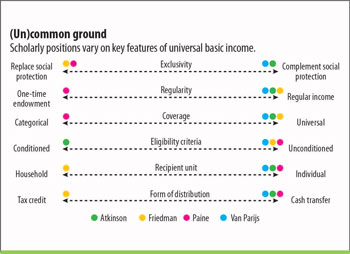What Is Universal Basic Income?
Proponents hail simplicity and equity; skeptics worry about fiscal cost and incentives

Many governments pay pensions to elderly people, or unemployment benefits to those who lose their jobs, or child benefits to families. Cash transfers to households are common in most countries. What is a universal basic income, and how is it different from these programs?
Universal basic income is an income support mechanism typically intended to reach all (or a very large portion of the population) with no (or minimal) conditions.
Discussions around universal basic income can be heated, both in a scholarly context and in public discourse, and there is no established common understanding. Very different income-support programs are often labeled "universal basic income," even when they have little in common or do not aim at the same goal.
Many ongoing and prospective experiments with universal basic income around the world refer to very different interventions. Examples include cash transfers to a selected group of unemployed people for a short time in Finland, to adults for 12 years in Kenya, and to randomly chosen households in California. This diversity reflects the absence of a unified definition and assessment methodology in both the literature and policy discourse.

Programs typically grouped under the universal basic income umbrella have a mix of key features (see chart). Does it replace or complement other social protection programs? Is the recipient an individual or a household? How is the pool of beneficiaries defined? What is the timing of the payment? Are there conditions attached?
Depending on how these key features are chosen and combined, scholars have proposed various forms of universal basic income (see chart).
Thomas Paine’s (1797) "ground-rent" resembles a categorical capital grant
(for example, a one-time endowment to a specific group of people) aimed at
fighting the transmission of poverty from one generation to the next.
Milton Friedman (1968) saw the "negative income tax" as a way to replace
the entire American welfare state to overcome administrative
inefficiencies. Philippe Van Parijs (1992) advocates a regular, universal,
unconditional, and generous cash transfer. Anthony Atkinson’s (1996)
"participation income" complements existing social programs and the minimum
wage and is conditioned on a form of "social" participation—
contributing to society through employment, education, childcare, or other
activities. Across this broad spectrum, however, two common traits
characterize and differentiate universal basic income-type programs from
others:
Universality —or very large—coverage of individuals in society
Unconditionality —or very broadly conditioned provision—as is the case of Atkinson’s "participation income"
Proponents and opponents of universal basic income have highlighted several aspects, and arguments in its favor mirror those opposed. Some advocates point out that it does a better job of reaching the poor than means-tested programs—that is, programs that determine individual or family eligibility for government assistance based on an income or asset test. Many factors can keep means-tested programs from reaching the intended recipients—for example, administrative capacity, high information and administrative costs, poor performance of targeting mechanisms, and social stigma.
In principle, simple universal basic income programs could save administrative costs and increase the transparency of transfer systems, making them less subject to administrative discretion and corruption. Advocates also tout its usefulness as a strategic instrument to support structural reforms such as removal of inefficient programs like energy subsidies (Coady and Prady 2018). Universal basic income programs can improve efficiency by avoiding sharp withdrawal of benefits as earned income increases, a common problem in many means-tested programs, which tends to discourage labor market participation.
Opponents tend to focus on sustainability—high fiscal costs since all households—including middle- and high-income households that do not need income support—receive the benefit. Skeptics worry about efficiency issues—warning against the undermining of work ethics—and opportunity costs—the risk of diverting scarce resources from other priorities such as health, education, and investment.
Assessment of the merits of such programs must take into account country-specific characteristics and societal preferences. It should also be anchored in a thorough understanding of the trade-offs when choosing one type of design over another.
Empirical analysis can shed light on the relative redistributive performance of existing social safety nets, a universal basic income, and potential alternatives. Given that both the spending and the tax side of the budget shape distributional outcomes, a comprehensive analysis should evaluate both to ensure progressivity—that is, gradually increasing net burden on more affluent households and larger benefits for more vulnerable households. Such an analysis must also consider fiscal sustainability. Typically, policymakers face trade-offs along the following key dimensions:
Coverage at the bottom of the income distribution versus leakage to richer households
Generosity of transfers versus incentives and economic distortions, such as those related to the decision to enter the labor market and the number of hours worked
Fiscal cost versus alternative use of scarce fiscal resources
Policymakers must also consider a fourth aspect: how to reconcile objectives and implementation challenges, such as the government’s capacity to raise resources equitably and sustainably and roll out a complex transfer program.
Scholars disagree on whether a universal basic income is more appropriate
for countries with limited and ill-functioning safety nets or for rich
countries that can afford it. Limited administrative capacity argues for a
shift toward more universal transfer programs in developing economies. But
displacement of other priorities (such as education and health) where
revenue mobilization is problematic—
particularly in the short term—is a concern.
In advanced economies, universal basic income is often used as an instrument to address inadequate safety nets (and ensure inclusion) and a way to tackle the challenges of technological and demographic changes. Country authorities must assess the relative merits of universal basic income including its financing through rechanneling resources already used in other ways or through higher taxes and contributions.
ART: THE NOUN PROJECT / MASSUPA KAEWGAHYA
Opinions expressed in articles and other materials are those of the authors; they do not necessarily reflect IMF policy.
References:
Atkinson, Anthony B. 2015. Inequality. What Can Be Done? Cambridge, MA: Harvard University Press.
Coady, David, and Delphine Prady. 2018. "Universal Basic Income in Developing Countries: Issues, Options, and Illustration for India." IMF Working Paper 18/174, International Monetary Fund, Washington, DC.
Friedman, Milton. 1968. "The Case for the Negative Income Tax: A View from the Right." In Issues of American Public Policy, edited by J. H. Bunzel. Englewood Cliffs, NJ: Prentice-Hall.
Paine, Thomas. 1797. Agrarian Justice.
Van Parijs, Philippe, ed. 1992. "Competing Justifications of Basic Income." In Arguing for Basic Income: Ethical Foundations for a Radical Reform . London: Verso.







